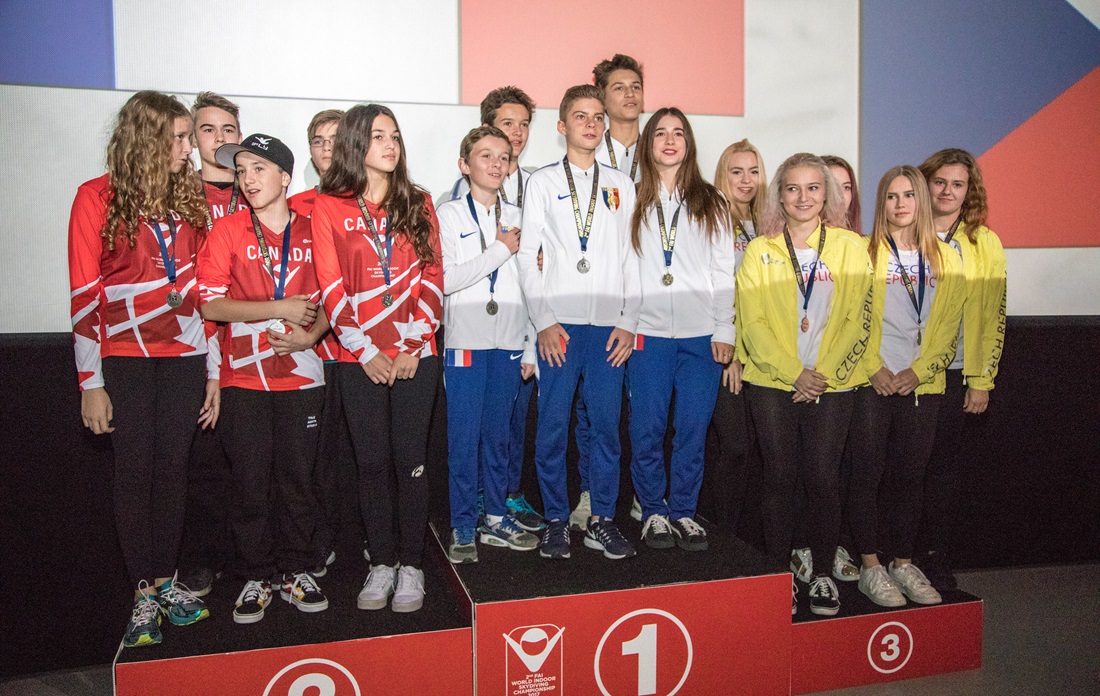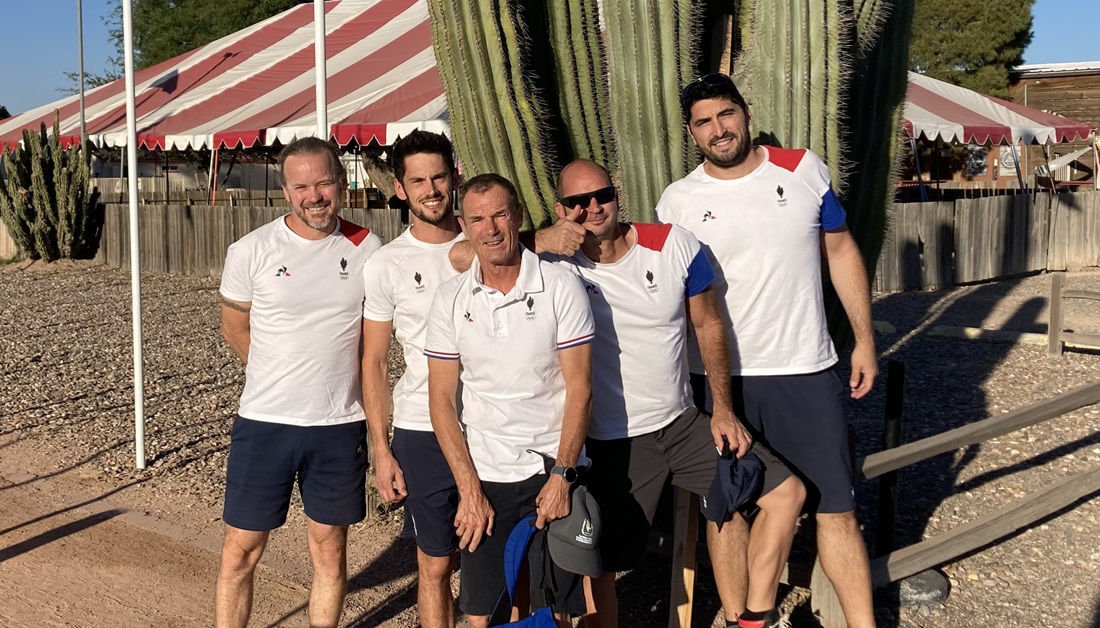Liberty, equality and fraternity: Philippe Schorno's career in skydiving
In 1988, thirty champion skydivers dressed in blue, black, red, yellow and green, jumped from a Chinook helicopter, made an Olympic Ring formation above the city of Seoul and landed in the Olympic Stadium as part of the Games’ Opening Ceremony. Among them was French skydiver Philippe Schorno.
According to the International Skydiving Museum & Hall of Fame, “That extraordinary jump, more than any other skydive before, helped to change the world's perception of skydiving.” This acclaimed event was a momentous sporting achievement for this young skydiver and came in the midst of his four-way team’s run of success, gaining four gold medals in four consecutive years. Also around this time his team gained a world skydiving record for longest sequence, with 19 formations in 1989 and 26 formations in 1993.
Do these remarkable achievements still make it to the top of Schorno’s proudest moments? And how has skydiving changed in the decades since the 1988 Olympic jump? After an illustrious career coaching various skydiving disciplines and bringing the French team to the forefront of the sport, we caught up with him to reflect on his legacy.

Philippe Schorno (right) in his competing days, alongside team mates (L-R) Jérôme Bunker, Frank Mahut and Eric Fradet
Champion mentality
During the years you were competing in 4-way open class formation skydiving, you won four gold medals in four consecutive years (1987 - 1989 - 1991 – 1993), having snatched success from the dominant US team. The pressure by the 4th world championships must have been intense! How did you handle that pressure and how has that experience helped your coaching career?
When we started the French Formation Skydiving 4-way team in the 1980s no French team had ever brought home the title. The expectations were therefore significant, as was the pressure. We managed and enhanced this pressure thanks to unwavering motivation and cohesion. Planning our training to strengthen our weaknesses was also key to success. It is important to be bold, with elevated but not unachievable goals.
On a personal level, pressure is part of competition and is in fact necessary to accomplish great performances and surpass yourself. The management of that pressure must happen prior to competition during training, when rigour and honesty about your strengths and weaknesses must be the leitmotif. If, as I have sometimes noted as a coach, one always credits one’s errors to external causes, this lack of personal questioning will make competition difficult to manage.
You have coached formation skydiving, artistic events, vertical formation and canopy piloting. Do you know how many of your athletes have become world champions?
Almost all of them across all those disciplines. At least 40 gold medals since 1985 in major events.
In fact, when we peruse Schorno’s CV, the number of golds his athletes have achieved since he commenced as a trainer in 1996 is 48, with 33 silvers and 23 bronzes, making 104 in total.
Jumping into new disciplines
As wind tunnels started revolutionising the sport of skydiving, Schorno became coach for the French national Indoor Skydiving team between 2015-2017, where his athletes gained two golds.
What have been the most significant developments in skydiving generally, since you were a competitor? Have wind tunnels helped to bring new participants to the sport?
Wind tunnels are without a doubt the biggest factor in the practise of competitive skydiving. I remain persuaded that to make competing in skydiving attractive, it is an extraordinary tool.
By spotting youngsters from 8-10 years old and training them in competition disciplines in wind tunnels we develop their love of flying and increase our talent pool so they can try jumping from the plane as soon as they are old enough.

French Junior Champions in Formation Skydiving 4-Way at the 2017 2nd FAI World Indoor Skydiving Championship in Canada. Photo: FAI / Marcus King
Schorno then moved into coaching the new sport of Canopy Piloting in 2012, where to date, he has yielded 39 medals for his team. The team are currently training for 2024 competitions including Pretoria, South Africa 19 Sep-24 Sep 2024.
Eyes on the prize
What has been your involvement in starting training and talent spotting for the new generation of canopy pilots?
The new sport of Canopy Piloting was awaiting development in France. It was an exciting challenge because everything had to be started from scratch.
With the French Parachuting Federation we organised talent spotting sessions, highlighted the value of French Championships, encouraged talented young skydivers to train in canopy piloting and finally put together a group of competitors to train, with the objective of becoming World Champion. (The team has achieved 19, so far.)
When coaching the French team, what is your strategy for preparing for an international competition? Do you travel overseas to train?
Yes, we travel overseas regularly for our winter training period. We also do at least one training session at the site of a forthcoming competition.
The importance of infrastructure
How does the French government support the training process, and air sports in general, considering France has maintained an excellent level in many FAI air sports disciplines?
The French state support for this sport has two main axes:
a) It provides human resources such as technical advisors and coaches to the sports federations, covering their salaries. For this, one must pass the sports coaching qualification and the federation concerned must seek the person they require.
b) The French state also provides financial assistance to the sports federations for athletes’ training.
There are some top female canopy pilots on the scene, but do you have any thoughts on how more women could be attracted to canopy piloting?
Firstly, I’d like to acknowledge those women currently participating in canopy pilot competitions. They are at the top of the discipline, and their talents, rigour and motivation is a benchmark for our young competitors. I know the question often arises over having a female category in Canopy Piloting, like in Formation Skydiving. I am not at all convinced it would be a good thing. For one thing, because if we take the example of Formation Skydiving, here it has not helped the development of the women’s discipline because it is still very niche. Secondly, I believe that the women are as strong and talented as the men, and that they compete with the same means as the men. Actually, Canopy Piloting is similar to other skydiving disciplines with the correlation being around 30% female participation.
Canopy Piloting requires significant experience under the wing, so a high number of jumps. This often implies former competitors in other disciplines or instructors, so the choice becomes more limited. Skydiving and Canopy Piloting are not disciplines where physical factors prevail over performance, so it is not necessary to differentiate between genders. A way of promoting the sport to women would be to create a women's ranking during open competitions. That is to say, keep the current ranking of competitions and add to this with a women's ranking as well. Personally, I am not even sure that this idea would be interesting to the current top female competitors who are capable of winning open World Championships.
How do you see the Canopy Piloting discipline developing as the equipment evolves, ie. with canopies and the mutant harness?
The mutant harness allows for prodigious performances but it requires a lot of rigour in the commitment and the piloting. The smaller wing sizes and the speeds they obtain are currently only mastered by a few competitors. But like all technical advances, we can bet that future competitors will be able to tame them more quickly.
Currently, the distances and speeds are leading to reflections on the development of competition formats. For the speed, it is difficult to follow the trajectory when the time is regularly under two seconds, or less, with a powerful tailwind. The same goes for distances: there are few ponds suited to competitions for distances of around 200 metres. The different formats offered by the FAI Skydiving Commission (ISC) offer solutions to these difficulties. One shouldn’t hesitate to use them to avoid accidents or to avoid truncating competitions because they can only be run without wind or with a headwind.

Philippe Schorno (centre) and the French team in Arizona 2023. Credit: Fédération Française de Parachutisme
Making memories
What have been the proudest moment in your career?
I have many moments in my career where I have been proud; these are the most significant:
- The recognition from the international skydiving community for the results obtained in the discipline in which I train athletes. It is a particular source of pride when you have never practiced the discipline yourself.
- Our 1991 4-way Formation Skydiving title with a 50% new team, competing against a famous US team which was quicker than us. The strategy implemented allowed us to achieve the impossible, making them doubt themselves and allowing us to win. I’m very proud of that.
- The first FAI VFS title won by France. When I trained this team the project seemed utopian, crazy even. Nevertheless, through the force of passion, motivation and conviction, the unlikely became achievable.
- Certain Artistic Freestyle titles, the freefly podium in Brazil’s World Championships where France won 1st, 2nd and 3rd.
- The titles won by Cédric Veiga Rios and the French CP team and those to come…
But what makes me most proud, and that which has most value in my eyes, are the close bonds of fraternity and friendship that I have had with most of the athletes I have had chance to select and train.
Ending on this lovely sentiment is a fitting tribute to all the skydivers who have benefited from Schorno's expertise. He has fully embraced the developments in the sport over the decades, identified what is required to become a champion, and led numerous athletes to proudly sing the French national anthem on the podium.

